or – ‘Potatoes a Hundred Ways’ – because you can go hundreds of ways from here!
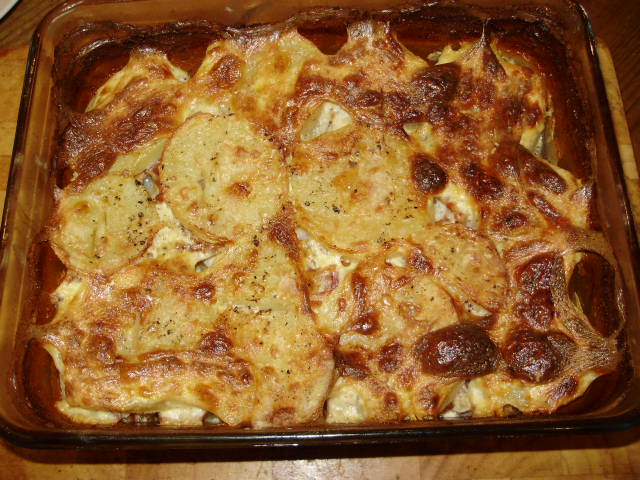 |
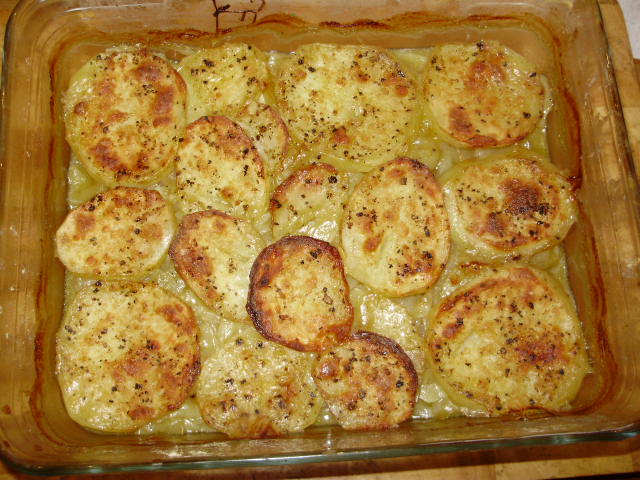 |
If you think potatoes are boring – think again! They’re versatile, cheap, filling, nutritious and available everywhere all year round. Even if you don’t grow your own – you’ll always be able to find potatoes somewhere. They’re a staple food of cultures all around the world and you can do almost anything with them. They’re a great vehicle for taking on other flavours. There’s endless variations that you can do of these once you’ve mastered the basic recipe, which my mother used to call ‘scalloped potatoes’.
For February’s Tunnel to Table recipe – I’ve cooked Potatoes Dauphinoise (with milk, cream and garlic and in my version – with chestnut mushrooms) and also Potatoes Boulangere (with onions and stock). Those names sound fancy and impressive – so they’re great for when you have the boss to supper! Actually they’re dead easy but despite that, there’s always a great “Ooh!” factor when you take them out of the oven and put them browned and bubbling on the table! They look really fabulous, they smell divine and are the ultimate comfort food.
Ingredients:
For both recipes you will need potatoes (how many depends on the size of dish you’re using, any variety is fine), butter if using, plain white flour, salt and pepper. I use freshly ground organic peppercorns which have a fabulous aroma and flavour compared to non-organic, as they’re much higher in the inflammation-reducing phytonutrients – terpenes – which also give them their delicious aroma.
For my Dauphinoise version, as well as potatoes, you will also need: Chestnut mushrooms, garlic, cream and milk.
If you prefer to use organic chestnut mushrooms as I do – you can find them in M&S, or in the Farmers Market in Drogheda on Fridays, where at least one organic stallholder has them. (I checked with him this morning – Feb19th). They are also available from the Organic Supermarket in Malahide, or online at www.OrganicSupermarket.ie
For the Boulangere version as well as potatoes, you will also need: Onions and stock.
I use Kallo organic vegetable stock cubes which have a lovely ‘herby’ flavour. Organic potatoes and onions are available everywhere now.
Once you have those basic ingredients – you can go absolutely anywhere you like from there! It’s very flexible – another of what I call my ‘convertible’ recipes. When you’ve mastered the basic version, there are countless variations that are all easy to do, it’s just a matter of adding one more ingredient. You don’t have to stress about the variety of potato – it annoys me when chefs insist on Desiree or some other particular variety – as you may not be able to get them and think you can’t do the recipe. Whatever potato you can get is just fine for this dish – but floury ones are nice.
Like the roast veg last month – this is another recipe that’s so easy it doesn’t even need exact measurements! Whatever size of dish you have is fine, depending on how many you’re feeding. But remember that you’ll be doing three layers – so leave enough room at the top (about 1 in or 3 cm) for a bit of ‘bubbling up’. This is particularly important in the case of milk if using – if it overflows you’ll mess up you’re oven big time unless you have an oven tray underneath!
Here’s a rough guide for a 2.6 litre casserole dish, which is what I use for this dish normally.
This amount serves 4 greedy or 6 dainty people – we’re greedy!
(a well know supermarket currently has a great offer on ‘stack & save’ Pyrex dishes if you collect their stamps. These are really useful for cooking in and then covering with the plastic lid to save any leftovers.)
METHOD:
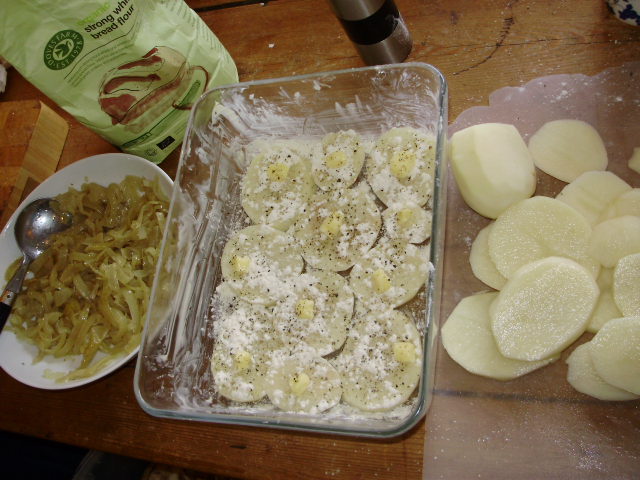 |
 |
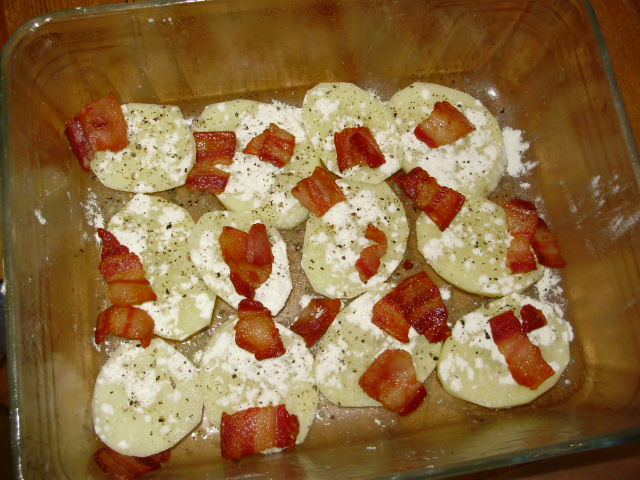 |
 |
1. Peel about 8 or 10 large spuds and slice them about 1/2cm or 1/8th inch thick. Don’t make them any thicker or they’ll be burned on top before the middle’s cooked. Make sure they’re all cut to the same thickness.The thickness is the important bit – the shape doesn’t matter. If you’re putting them in water as you peel them to prevent browning, make sure you dry them well before slicing or the dish will be too wet.
2. Slice the Onions if using and gently sweat them in butter or oil. Alternatively if using mushrooms, slice and and cook them in butter or oil until golden, adding a couple of cloves of minced garlic for the last minute or so but don’t let it burn. Bacon lardons must be cooked until crispy and browned before adding, as they won’t have time to cook enough if added raw – they also won’t add as much flavour. You can leave them cooking in a frying pan, stirring occasionally, while you get on with slicing the spuds.
3. Grease the dish well with butter or oil. Butter gives a better flavour if you’re not vegan. (see note **If you’re worried about using butter)
4. Put a single layer of the potato slices at the bottom – as close together as possible – it doesn’t matter if there’s a few gaps between their corners!
5. If you have a flour dredger then dredge with flour – or otherwise just scatter a good sprinkling with your fingers. Then dot a tiny pea sized knob of butter here and there on the potatoes. Season with salt and pepper (watch the salt if you’re doing the ‘Boulangere’ version with stock cubes which may have added salt)
6. Next scatter on that layer about half the quantity of one or more of whatever added ingredients you fancy. This can be crispy cooked bacon lardons,* browned cooked mushrooms, (I use a 250g pack, cooked until golden in a little bit of butter or oil), gently softened onions etc. (just until translucent – burned onions are bitter and taste horrible!) There’s endless other additions you could make, such as anchovies (again watch salt), cheese, chorizo, cooked chopped cold meat leftovers, tinned chopped tomatoes etc.
7. Then add the second potato layer in the same way, dredging with flour, seasoning and dotting with butter. Add the remaining mushrooms, bacon or whatever.
8. Finish with another layer of potatoes dredge the top with flour and dot with butter in exactly the same way.
9. Next add whatever liquid you like, until you can just see it through the top layer – almost level with top of 2nd layer is about right. It’s hard to be exact – but in this size dish it’s about 400ml of liquid, or slightly less.
For ‘Dauphinoise’ – add low or full fat milk – you can then drizzle with a little cream if you’re feeling slim, luxurious, or ‘what-the-hell’! Otherwise plain milk is fine.
For ‘Boulangere’ – add hot stock – either chicken or veg. stock – made with about 1 & 1/2 cubes in 400mls if using Kallo veg stock cubes.
Cook at 180-190deg. C (ovens vary) for about one hour until it’s nicely browned. I cook them at 190degC, sometimes turning down 10degC just before the end. Test with the point of a sharp knife about 10 mins before you think it might be done. If it feels soft then it’s done – but if there’s still a little resistance in the middle it’s not quite ready, so leave for another 10 or 15 mins. If the top starts to brown too much cover with some foil or greaseproof paper.
After taking out of the oven it will sit quite happily for some time keeping warm, just cover with foil so it doesn’t dry out.
You don’t really need anything extra with this except a green salad or a vegetable like the steamed cabbage below or broccoli is nice. if you already have some meat or cheese in it to make a balanced meal. But if you want an extra bit of protein with it, a steak piece of fish, a chicken breast or anything else is fine. It goes well on the side with anything – even nut loaf or burgers! The ‘Boulangere’ version also absolutely delicious cold – tastes like Cornish pasty without the meat! In fact – about halfway through you can add a puff pastry or shortcrust pastry lid to turn it into an impressive pie, using the dish lid as a template to cut out the pastry.
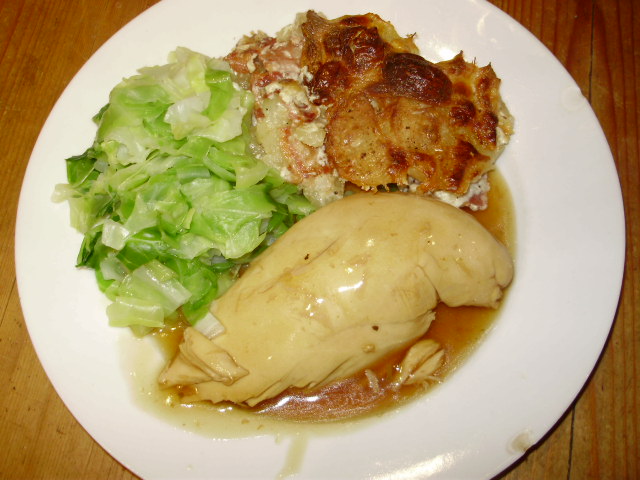
This recipe freezes brilliantly if you leave it until cold, cut it into portions, wrap and freeze. It heats up again very well either microwaved, in the oven or even gently on top of stove in a non-stick saucepan, after thawing first. I always find it really handy to have a few portions in the freezer.
If you want to make a completely vegan rather than vegetarian version – then just replace the butter with a few drizzles of a good olive oil. Some cashews are nice scattered throughout the layers. I love cashews with everything – and again – organic ones are a million miles away in flavour from non-organic. They impart their aroma to all dishes and when they’ve been sitting in the sauce for a while they become plumptious and absolutely delicious, like little flavour bombs!
** If you’re worried about using butter. The latest up to date research now shows that it isn’t butter or other natural saturated fats that cause heart disease. In fact it’s highly processed, refined carbohydrate-rich foods with lots of sugar and especially something called ‘High Fructose Corn Syrup’ – which is in nearly all processed foods like biscuits, chocolate bars, ready meals etc. The original research on cholesterol, done in the 1950’s – was carried out using rabbits! A bit daft as rabbits only eat green stuff, which doesn’t contain cholesterol – so their bodies aren’t adapted to dealing with it. As a result the rabbits had loads of cholesterol circulating in their blood when tested and that’s what all dietary recommendations have been based on up until now! We’re not rabbits!
If you’re using organic butter – some recent research in Newcastle University showed that it was more than 60% higher in good Omega 3 fats – which are the heart-healthy ones. I wouldn’t use anything else. I have never used margarines of any sort – even polyunsaturated ones – because they are unnaturally manufactured fats, which are now known to actually damage your arteries! By the way – garlic and onions are good for circulation too, so if you’re still worried – then just add plenty of those!